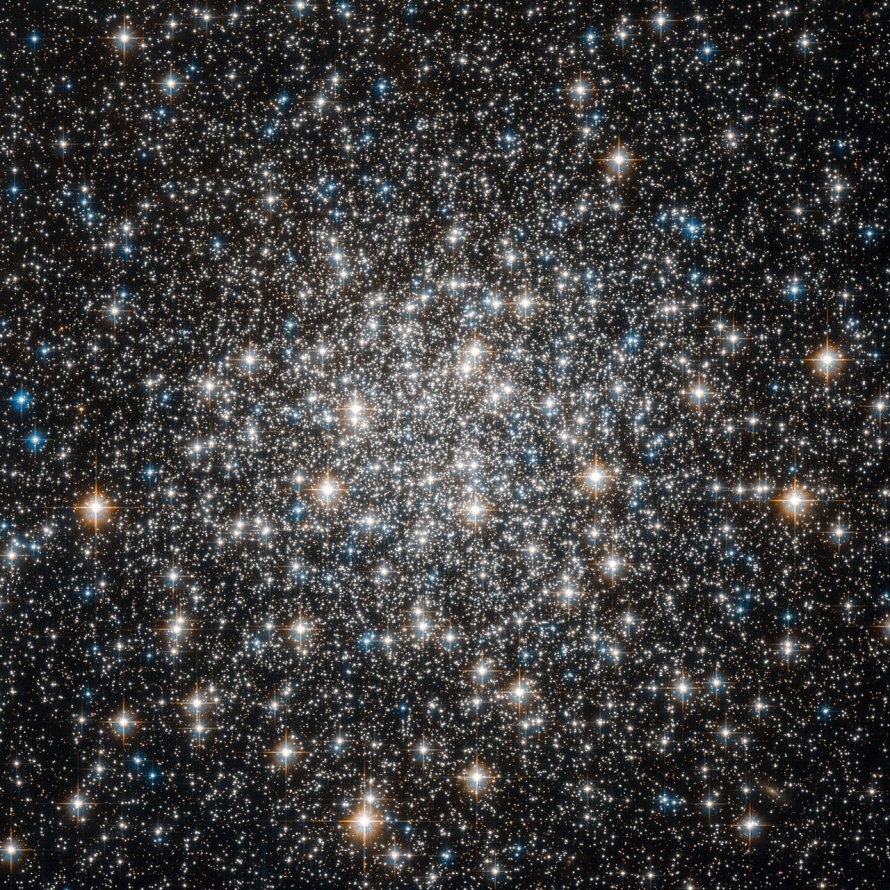M10 (NGC 6254)
Messier 10 (NGC 6254) is a globular cluster located in the constellation Ophiucus, in the Galactic Center of the Milky Way Galaxy in the Local Group of galaxies. M10 is 14300 light years away from Earth.
M10 is best viewed during mid-summer, is magnitude 6.4, and can be viewed with binoculars. M10 is 20' in apparent size. For reference, the full moon is 30'.
Observing difficulty: Intermediate
- Name:
- Type:
- globular cluster
- Constellation:
- Ophiucus
- NGC or IC:
- NGC 6254
- Magnitude:
- 6.4
- Viewing:
- binoculars
- Size:
- 20'
- Distance (light years):
- 14300 LY
- RA:
- 16h 57.1m
- Dec:
- -4 6'
- Season:
- mid-summer
- Milky Way location:
- Galactic Center
- Galaxy group:
- Local Group
- Messier Marathon #:
- 79
- Contains:
- 100,000 stars
* The naked eye can see up to magnitude ~7-8 objects under ideal dark sky conditions.
Exploring an Ancient Stellar Sphere
Messier 10 (M10) is a globular cluster, a dense, spherical assembly of stars, found in the constellation Ophiuchus. As a celestial object composed primarily of ancient stars, M10 offers a compelling opportunity to explore the early universe's characteristics. This article delves into the scientific and technical aspects of M10, discussing its discovery, physical properties, stellar composition, and scientific significance.
Discovery and Observation
M10 was first observed by French astronomer Charles Messier in 1764. Situated about 14,300 light-years away from Earth, M10 is one of the brighter globular clusters in the Messier catalogue. It can be observed with small telescopes and binoculars appearing as a fuzzy, round patch of light.
Physical Characteristics
M10 is classified as a Class VII globular cluster, indicating a moderately high concentration of stars towards its center. The cluster spans approximately 83 light-years in diameter, with a denser core region extending about 17 light-years. An interesting feature of M10 is the slight elliptical shape, which is unusual for globular clusters and likely results from our line of sight perspective.
Stellar Composition
M10 is estimated to be approximately 11.4 billion years old, making its stellar population significantly older than our Sun. The cluster is home to hundreds of thousands of stars, predominantly old, low-mass stars exhibiting low metallicity, in keeping with the elemental abundance of the early universe. It is comprised largely of red and yellow giants, although blue stragglers are also present. These are stars that appear younger than the cluster itself, likely the result of stellar interactions within the densely packed cluster.
Variable Stars
Variable stars, which fluctuate in brightness over time, are notably present in M10. The cluster is known to house at least 28 of these, the majority being RR Lyrae variables. These stars are particularly important as their luminosity directly relates to their pulsation period, making them excellent standard candles for distance measurements in astronomy.
Scientific Significance
The age, location, and composition of M10 provide a valuable resource for astronomers. Its old, metal-poor stars offer a snapshot of the early universe, enabling researchers to better understand the conditions and processes of star formation in the galaxy's early days. Additionally, the presence of variable stars in M10 offers an opportunity to refine distance scales in the universe, contributing to the broader understanding of cosmic structures.
Apparent Magnitude and Distance
Messier 10 has an apparent magnitude of 6.6, which, under optimal viewing conditions, puts it at the threshold of naked-eye visibility. However, to fully appreciate its beauty and resolve individual stars, binoculars or a small telescope are required. M10 is located approximately 14,300 light-years from Earth, which, though distant by human standards, is fairly close in astronomical terms.
Finding and Observing Messier 10
Located in the constellation Ophiuchus, M10 can be found in the sky by drawing an imaginary line between the stars Beta Ophiuchi and Zeta Ophiuchi. Around halfway along this line, you should be able to spot the faint glow of M10. The best time to observe this globular cluster is during the summer months when Ophiuchus is at its highest in the sky.
With the help of a star chart and a clear, dark sky, finding M10 is a feasible task for amateur astronomers. Binoculars may show it as a fuzzy, indistinct object, but even a small telescope should reveal its spherical shape. Larger telescopes and higher magnifications will further resolve individual stars, particularly towards the edges of the cluster, providing an even more rewarding viewing experience.



